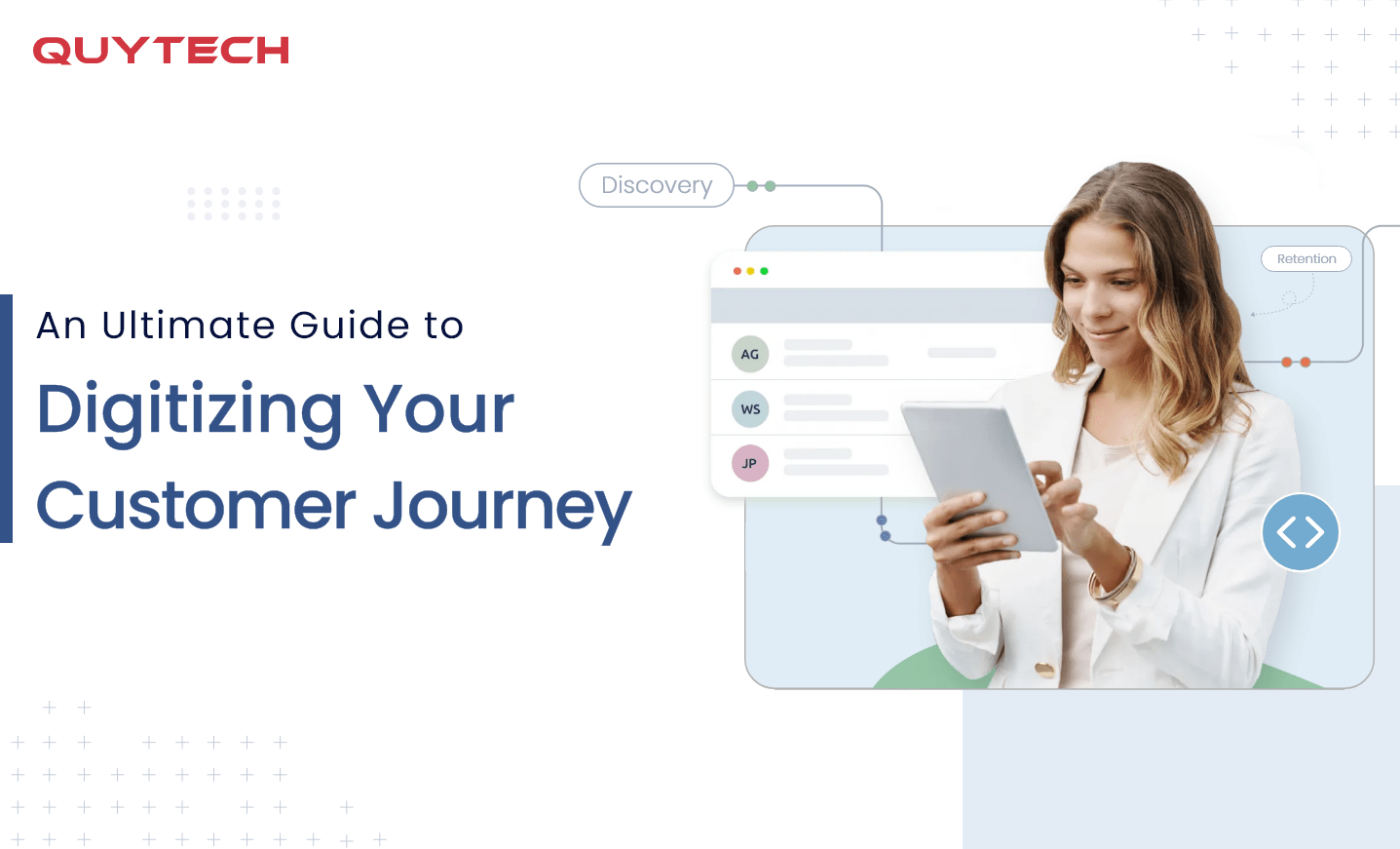In this rapidly evolving era of technology, businesses across industries are embracing digital transformation to engage with their customers and cater to their needs. One of the critical aspects of this revolutionary transformation is the digitization of the customer journey.
It entails leveraging advanced technologies and channels to ensure seamless and personalized interactions across mobile apps, websites, social media platforms, email, and more. By delivering standout experiences, businesses attract new and retain existing customers while minimizing customer complaints and service costs.
To understand why digitizing the customer journey matters more than ever before, let’s have a look at these interesting statistics:
- Digital transformation of customer journeys results in high customer engagement, and highly engaged customers purchase 90% more frequently.
- They are 6X more likely to try other products/services from the brand they have previously purchased.
- 4X more likely to recommend the brand to their family and connections.
- 2X more likely to shop from their preferred brand, even if its competitor offers the same product at a better price.
What is Customer Journey?
A customer journey includes how a customer goes through various stages of interaction when they first land on your website or mobile application. The journey starts right from the moment a customer spots they have a requirement and ends with purchasing the product or service.
5 Stages in the Customer Journey
The five stages involved in the customer journey are:
- Discovery
It is the first stage where the customer discovers they have a need. The discovery can be offline through word of mouth or TV commercials or online through the social media platform, google advertisements, or any other medium.
- Consideration
The customer considers the product or service a solution to their problem or need. In other words, it is the pre-sales part where the customer thinks about what they have discovered and whether they want to buy it.
- Decision
The third stage is the critical stage of the entire customer journey that involves a customer buying the product or service. Always remember that a complicated purchasing process results in cart abandonment. On the other hand, offering different payment options, automating data filling, and more increases customer experience.
- Retention
The customer feels satisfied with the product’s or service’s quality and decides to continue with the brand. A business can convince customers to stay by ensuring they have a positive experience during the first three stages.
- Advocacy
Only a satisfied customer recommends a brand to other potential customers. They act as a silent salesman of the brand. Always remember a retaining customer, especially those who recommend a brand, is more profitable than a new one.
5 Benefits of Digitizing Customer Journey

- Enhanced Customer Engagement
Digitizing the customer journey offers immense opportunities for businesses to engage with their customers via social media, email campaigns, or personalized messaging, which helps them create meaningful and tailored experiences.
Furthermore, it allows organizations to capture crucial data at each touchpoint to obtain actionable insights into customers’ preferences, needs, and behaviors. They can improve and strengthen the level of engagement and relationship, which fosters brand loyalty.
- Improved Personalization
Digitization of the customer journey assists with delivering personalized experiences. Based on the insights driven by gathered data, businesses can segregate their audience, display relevant content/products/services, and increases the chances of conversions.
- Hassle-Free Omni-Channel Experience
With customer journey digitization, organizations can deliver seamless omnichannel experiences. It means a lot for customers as they can effortlessly transition between various touchpoints, including the social media channel, mobile app, physical store, and website. It contributes to achieving customer trust and establishing a positive brand reputation.
- Improved Decision-Making
Integrating business intelligence into all the touchpoints helps businesses understand customers’ thinking at different stages. By mapping the customer journey, organizations can improve their marketing strategies to improve profitability, minimize customer complaints, keep track of changing customer expectations and market trends, and make better marketing strategies.
- Increased Operational Efficiency
Digitization eliminates unnecessary and redundant manual work, which increases operational efficiency and reduces overall costs. Moreover, it also minimizes the chances of errors associated with manual order processing, inventory management, customer data collection, and other crucial tasks.

Customer Journey Digitization: Success Stories
Starbucks

Starbucks, the global coffeehouse chain, needs no introduction. The brand has been at the forefront of digital transformation in the retail sector. Starbucks has developed a mobile app to allow customers to seamlessly place orders, make payments, and earn rewards or loyalty points.
Apart from delivering the utmost convenience, the digitization of the customer journey is also helping the brand to gather valuable data to personalize offers and recommendations for its customers. It has also resulted in a significant increase in brand loyalty, customer engagement, and revenue.
Amazon

Amazon, the largest e-commerce giant, has also entered this race of digitizing the customer journey to deliver its customers an unmatched e-shopping experience by displaying them tailored product recommendations, dynamic pricing, and custom marketing messages.
By integrating personalization in its app and website, the company has improved customer satisfaction to a significant extent. It has also led to Amazon’s tremendous growth and dominance in the eCommerce industry.
Sephora

The worldwide renowned beauty retailer has also embraced digital innovation to improve its customer journey. It has developed the Sephora Virtual Artist app to allow customers to try on different makeup products virtually.
The app delivers a personalized and immersive shopping experience, which enhances customer satisfaction and amplifies in-store and online store sales.
4 Roadblocks to Digitizing Your Customer Journey

- Inability to Ensure Data Privacy and Security
Enhancing the customer journey through digitization involves collecting crucial customer data, such as their phone number, credit/debit card details, addresses, and more. Businesses must adopt top-notch security measures and adhere to data privacy and security regulations to ensure the security of this data.
- Lack of Resources
Digitizing customer experience may require an organization to hire or upskill its personnel with expertise in various elements, such as UI/UX design, data analytics, artificial intelligence, and more. Lack of resources may become an obstacle to digitized system development.
- Inconsistency in Customer Experience
Offering a consistent customer experience across all digital platforms and store touchpoints is crucial to delight your customers and earn brand loyalty. Even a minor inconsistency in the design, functionality, or messaging can create chaos and impact customer experience.
- Cost Concerns
Automating the customer journey requires a business to invest in training, infrastructure, and technology. While this investment is worth it, a company with a limited budget and no measures to calculate ROI (Return on Investment) might think twice to begin with the digital transformation roadmap.
How to Create a Digital Customer Journey Map?
- Set Your Goals for the Map
Before creating a digital customer journey map, define your goals to establish what you want to achieve from the map. Is it to drive more sales or identify loopholes in the onboarding process? Do you wish to extend your business or improve your customer retention rate? Questions like these will help you understand your aim behind creating a digital customer journey.
- Identify Your Target Audience
Define your customers’ personas by capturing their most common characteristics, such as demographics, behavior, goals, and problems. By understanding these four points, you can understand your customers and their needs in a better way. For example, as a skincare brand, you may find that your most profitable customers are females aged between 16 to 50.
- Define Customer Touchpoints
Decide different touch points where a customer will interact with your brand digitally. It might include visiting a website or mobile app, social media engagement, email communication, or any other platform.

- Collect Data
Gather data from different interactions a customer makes at various points. To make this possible, businesses can take the help of various analytics tools, customer feedback, surveys, etc. The insights obtained from this data can improve customer experience and understand their pain points.
- Map Customer Actions
Keep track of customers’ actions and the emotions they experience during the journey. Doing this would help you align your digital strategies with your business goals and customers’ needs.
- Review and Improve
Measure the performance of your customer journey; evaluate customer feedback and surveys to identify loopholes. Make necessary adjustments to deliver a seamless and smooth customer experience.

5 Best Practices to Digitize Your Customer Journey
- Adopt a Customer-Centric Approach
Make your customers the center of your digital strategy. Focus on their needs and preferences, and design the digital experience accordingly. Continuously collect feedback to refine and enhance the journey.
- Ensure Omnichannel Experience
Offer a seamless and consistent experience across all digital channels. Ensure your customers can smoothly transition between all channels, such as mobile apps, websites, social media, etc., without losing the context or facing any disruption. Also, the branding or messaging should be consistent across all digital touchpoints.
- Personalization and Customization
Make the most of collected customer data and analytics to personalize and digitize your customers’ journey. Leverage top-notch technologies like artificial intelligence to achieve this goal.
- Streamline User Experience
To ensure a streamlined user experience, focus on designing simple interfaces with intuitive navigation and fast-loading of website and mobile applications. Also, conduct regular usability testing and make adjustments based on user feedback.
- Focus on Data Privacy and Security
Adopt all necessary measures to ensure complete privacy and security of your customer data. Adhere to the security guidelines and company with standard data protection regulations. Let your customers know about your data collection and usage policies; it will ensure transparency and build customer trust.
Bottom Line
Digitizing your customer journey or experience starts when a customer discovers a product/service and ends with its purchase. It involves five critical stages: discovery, consideration, buying, retention, and advocacy.
Implementing automation in each stage results in improved personalized, enhanced customer engagement, improved decision-making, and increased operational efficiency. Doing so requires technical expertise and experience in top-notch technologies such as artificial intelligence, machine learning, and more.
Here is when Quytech comes into the picture. We are a well-recognized mobile app development company that has helped businesses to digitize their customer journeys by defining each milestone and integrating automation. To know more about it, reach us today.


